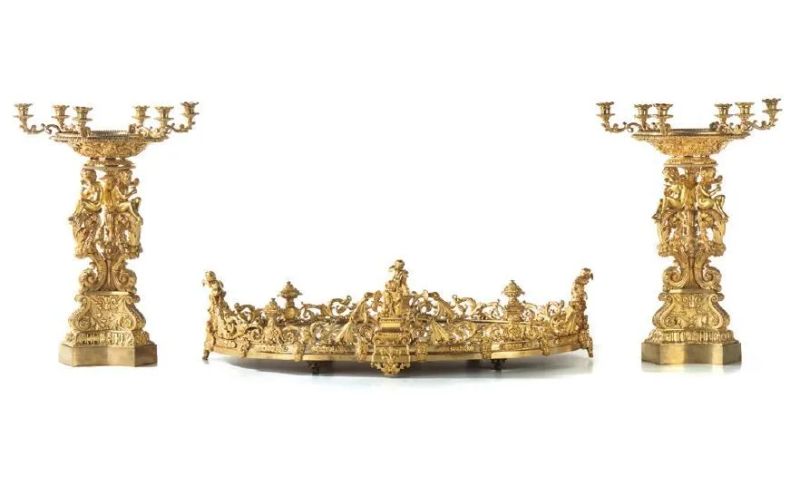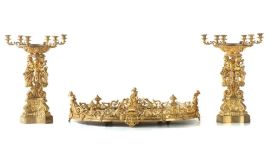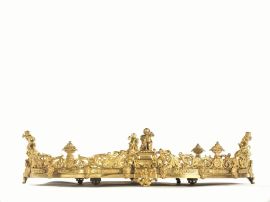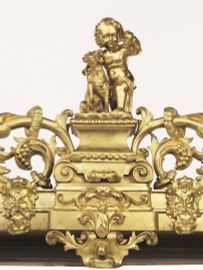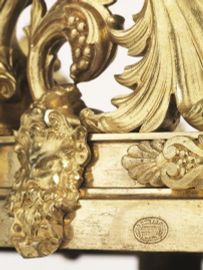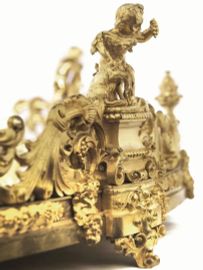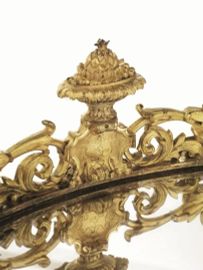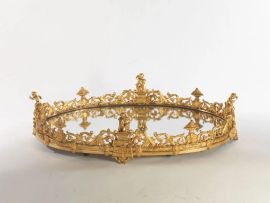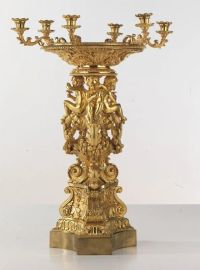Auguste Breul
SURTOUT DE TABLE COMPOSTO DA VASSOIO OVALE E COPPIA DI CANDELABRI, PARIGI, 1855 CIRCA
Bronzo dorato, vassoio cm 103x67x25, candelabri alt. cm 62, diam. massimo cm 51
Sul basamento il vassoio reca il punzone “AUGUSTE BREUL - N° 20 RUE DE ALBOUY - A PARIS”; i candelabri, invece recano il punzone “AUGUSTE BREUL - RUE DE LANCRY N° 3 - A PARIS”
SURTOUT DE TABLE COMPOSED OF AN OVAL TRAY AND A PAIR OF CANDLEHOLDERS
Paris, circa 1855
Ormolu, tray 103x67x25 cm, candleholders h. 62 cm, maximum diameter 51 cm
On the base of the tray, mark “AUGUSTE BREUL - N° 20 RUE DE ALBOUY - A PARIS”; on the candleholders, mark “AUGUSTE BREUL - RUE DE LANCRY N° 3 - A PARIS”
Provenienza
Collezione privata, Firenze
Il vassoio poggia su quattro piedi sagomati a guisa di foglia accartocciata affiancata da due fregi vegetali, in corrispondenza dei quali si ergono quattro gruppi posti su un ricco basamento sagomato, bordato di perline e baccellature, raffiguranti ciascuno un putto con un grappolo d’uva nella mano sinistra, abbracciato ad una capretta; intervallati ai putti quattro trofei costituiti da belle coppe baccellate sormontate da composizioni di frutta. La fascia inferiore è interamente decorata da festoni vegetali alternati a mascheroni barbuti, mentre la ringhiera, decorata da putti e trofei, è completata da tralci floreali e vegetali.
I due candelabri poggiano su una base triangolare liscia lievemente sagomata e decorata da una fascia a baccellature intervallate da foglie d’acanto. Da un alto basamento caratterizzato agli angoli da tre ricche volute riunite da motivi vegetali si dipartono tre tralci fogliati con andamento sinuoso, ciascuno impreziosito da una ghirlanda di frutti e foglie, sui quali siedono tre putti con una coppa nella mano destra e un grappolo d'uva nella sinistra, alla sommità un’ampia vasca circolare, anch’essa decorata a motivi vegetali, foglie lanceolate e perlinature, dalla quale si dipartono sei bracci portacandela, ancora sagomati ad ispirazione vegetale.
The tray is supported by four feet in the shape of curled up leaves flanked by two foliate motifs, on top of which stand four groups of figures on an elaborate moulded base with beaded and gadrooned borders; each group comprises of a putto holding a bunch of grapes in his left hand and with the other arm around a goat; four trophies, composed of beautiful gadrooned goblets heaped with fruit, alternate with the putti. The lower band is fully decorated with swags interspaced by bearded masks, while the gallery, decorated with putti and trophies, is cast with floral and foliate scrolls.
The two candelabra are supported by a slightly moulded, smooth triangular base decorated with a band with gadroons alternating with acanthus leaves. Three sinuous foliate scrolls, each embellished with a fruiting and foliate garland and supporting a putto with a cup in the right hand and a bunch of grapes in the other, stem from a high plinth with plant motifs and three luxuriant volutes in each corner; at the top a wide circular basin, also decorated with foliage, lanceolate leaves and beaded motifs, supports six, moulded, scrolled candle-arms.
SURTOUT DE TABLE DI AUGUSTE BREUL PROVENIENTE DA PALAZZO LARDEREL DI LIVORNO
Auguste Breul, orologiaio e bronzista attivo a Parigi alla metà dell’Ottocento, realizzò nella sua bottega centrotavola, candelabri, orologi e molti altri oggetti in bronzo che andarono a impreziosire sale da pranzo e salotti delle migliori famiglie nobili d’Europa. Fu grazie a uno stile riccamente ornato, caratterizzato da un’estrema raffinatezza di esecuzione, unitamente all’originalità dei modelli creati, che Breul divenne l’artista di riferimento di quanti desideravano bronzi realizzati secondo l’ultima moda parigina.
A conferma del prestigio raggiunto da Breul a metà del Ottocento va segnalata l’importante commissione ricevuta nel 1850 dal ministro austriaco a Parigi, il conte Graf Hübner, il quale gli diede l’incarico di far realizzare un servizio da tavola per il giovane imperatore Francesco Giuseppe d'Austria. Il conte, recatosi nei laboratori del bronzista, inviò a Vienna i disegni di due progetti: il lavoro venne affidata nello stesso anno, e nell’aprile dell’anno successivo Breul consegnò all’indirizzo privato del principe di Liechtenstein i suoi centrotavola, in seguito portati alla residenza di Hofburg. Tutta la vicenda si svolse nel più grande segreto: erano infatti gli anni che seguivano le rivoluzione del 1848 e gli impegni economici dello Stato erano prevalentemente rivolti al rilancio economico del paese e al sostegno delle manifatture locali: ma un centrotavola à la mode realizzato secondo l’ultimo grido parigino dal suo più raffinato bronzista era un’occasione di prestigio troppo grande.
Ad Auguste Breul intorno alla metà dell’Ottocento si rivolse anche Francesco Filiberto Larderel per arredare il palazzo appena costruito. Il Larderel nacque a Vienne in Francia nel 1789 e si trasferì a Livorno in età napoleonica, dove era descritto negli almanacchi del 1814 come "chincagliere". Nel successivo quindicennio, sfruttando le risorse geologiche dei lagoni del Volterrano, promosse e sviluppò l'industria dell'acido borico, accumulando un cospicuo patrimonio.
La sua ascesa nel panorama imprenditoriale del Granducato di Toscana coincise proprio con la costruzione dell’imponente palazzo residenziale di quattro piani lungo la via dei Condotti Nuovi, terminato nel 1832 e costato 70.000 lire: momento questo che gli aprì le porte del notabilato cittadino e fece della sua residenza un centro della vita sociale e mondana della città. Arricchito di arredi e di una collezione d'arte antica e moderna, il palazzo pose il Larderel nel novero dei mecenati e dei benefattori cittadini. Del 1837 infatti è l'editto sovrano che gli permise di assumere e usare il titolo di conte di Montecerboli, la località nella quale aveva "eretto i grandiosi stabilimenti di sal borace", e non a caso nello stemma nobiliare risalta l'immagine dei soffioni e delle fabbriche. Fregiato di tale titolo, poi riconosciuto come ereditario, di quello di cavaliere di San Giuseppe, onorato dell'ingresso al casino dei nobili di Firenze e della nomina del figlio Enrico a regio ciambellano (1851), il Larderel poté accedere alla corte granducale, con la conseguente opportunità di stringere legami matrimoniali con famiglie di grande prestigio e antica nobiltà, come i Rucellai e i Salviati, infine anche con i Savoia (nel 1872 la nipote Bianca sposerà il figlio morganatico del re d’Italia, il conte di Mirafiori Emanuele Alberto).
Bibliografia di confronto:
Dictionnaire Des Horlogers Français, a cura di Tardy, Paris 1972, p. 98, per l’attività di Auguste Breul come orologiaio;
Ehemalige Hofsilber & Tafelkammer: Silber, Bronzen, Porzellan, Glas, a cura di H.C. Winkler, Wien, Koln, Weimar 1996, pp. 92 e 107, per l'attività di Auguste Breul presso la corte viennese;
L. Fischer Frattarelli, LARDEREL, Francesco de, in Dizionario Biografico degli Italiani, volume 63, 2004 per Francesco Filiberto Larderel
A SURTOUT DE TABLE BY AUGUSTE BREUL FROM PALAZZO LARDEREL IN LIVORNO
Auguste Breul, clockmaker and bronze-worker active in Paris in the mid-19th century, in his workshop executed centerpieces, candelabra, clocks and many other bronze objects which would embellish the dining rooms and the sitting rooms of the best noble families in Europe. It was thanks to his lavishly ornate style, to the extremely refined workmanship along with the originality of his models that Breul became the most sought-after artist for those who wished to possess bronzes of the latest Parisian fashion.
The prestige Breul achieved in the mid-19th century is confirmed by the important commission he received in 1850 by the Austrian minister in Paris, Count Graf Hübner, who entrusted him with the execution of a dinner service for the young emperor Franz Joseph of Austria. The count, after visiting the laboratories of the bronze worker, sent the drawings of two projects to Vienna: the commission was assigned the same year, and the following April Breul delivered his centerpieces to the private abode of the Prince of Liechtenstein, which were later transferred to the Hofburg residence. Everything was conducted with the utmost secrecy: those were in fact the years following the 1848 revolution and finances were mainly directed at re-launching the economy of the country and at supporting the local manifactures: nevertheless, a surtout de table à la mode executed in the latest Parisian fashion from its most refined bronze worker was too prestigious an occasion to be missed.
Around the middle of the 19th century Francesco Filiberto Larderel also turned to Auguste Breul to furnish his newly built palace. Larderel was born in 1789 in Vienne, France, and had moved to Livorno in the Napoleonic era, where the 1814 almanacs described him as a “chincagliere” (= seller of knick-knacks). In the following fifteen years, exploiting the geological resources of the lagoni in the area of Volterra, he sponsored and developed the boric acid industry, accumulating a small fortune.
His ascent in the entrepreneurial field of the Grand Duchy of Tuscany coincided with the building of the impressive four storey residential palace along Via dei Condotti Nuovi, completed in 1832 with a cost of 70.000 lira: an event which opened up the doors of notoriety for him in the city, and made his residence the centre of the fashionable social life in Livorno. Thanks to his palace, richly furnished and containing a collection of antique and modern art, Larderel became one of the patrons and benefactors of the city. The king’s edict that allowed him to take on and use the title of Count of Montecerboli dates, in fact, to 1837: this was the name of the place where he had “erected the imposing borax plants”, and it’s no coincidence that fumaroles and factories appear in his coat of arms. With this title, which later became inheritable, with the title of Knight of the Order of Saint Joseph, honoured with the possibility of having access to the Casino dei Nobili of Florence and with the designation of his son Enrico as royal chamberlain (1851), Larderel was able to enter the Grand Ducal court, with the resulting opportunity of being able to create marriage bonds with prestigious families of ancient nobility, such as the Rucellai and the Salviati, and finally also with the Savoia (in 1872 his granddaughter Bianca would marry the morganatic son of the King of Italy, Emanuele Alberto count of Mirafiori).
Comparative literature
Dictionnaire Des Horlogers Français, edited by Tardy, Paris 1972, p. 98, for Auguste Breul’s activity as a clockmaker;
Ehemalige Hofsilber & Tafelkammer: Silber, Bronzen, Porzellan, Glas, edited by H.C. Winkler, Wien, Koln, Weimar 1996, pp. 92 and 107, for Auguste Breul’s activity at the Viennese court;
L. Fischer Frattarelli, LARDEREL, Francesco de, in Dizionario Biografico degli Italiani, vol. 63, Roma 2004, for Francesco Filiberto Larderel

